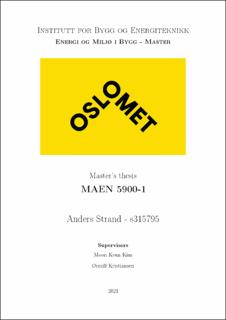Comparative energy analysis and performance estimation of decentralized ventilation control strategies in local Norway climate
Master thesis
Published version
Permanent lenke
https://hdl.handle.net/11250/2831686Utgivelsesdato
2021Metadata
Vis full innførselSamlinger
Sammendrag
The present work evaluates different decentralized ventilation control strategy and supply temperature regulation strategy combinations in local Norway climate and is the main focus.
Field measurements on decentralized ventilation systems are utilized, which is further applied to mold a representative decentralized ventilation unit for evaluation of energy performance in a single-person reference zone. Evaluation is performed using a monthly time-step energy analysis, and the IDA ICE simulation tool for a comparative primary energy analysis on the strategy combinations, while simultaneously agreements of the national requirements are upheld. Primary energy comparison is conducted with respect to a centralized constant air volume (CAV) system, which is compared with all decentralized ventilation strategy combinations for a full comprehensive comparative analysis. The strategy combinations are assessed with respect to comfort criteria for a better understanding of the strategy potential. Assessment of the decentralized ventilation heat recovery unit applicability in local Norway climate is conducted based on seasonal energy analysis. Furthermore, the strategy combinations are tested with respect to higher occupancy zones, and also by using commercially available decentralized ventilation unit specifications for a wider understanding of the decentralized ventilation potential in local Norway climate.
The results of the evaluation show that the representative decentralized ventilation system has the greatest energy performance under demand controlled ventilation control strategies, as the lower heat recovery efficiency is less utilized in the cold climate, and the low specific fan power can efficiently be used for zone cooling in summer.
If the commercially available decentralized ventilation system does not exaggerate the given specifications, the decentralized ventilation technology has great potential in Norway climate due to the high heat recovery unit efficiency and low specific fan power, and supply air strategies such as natural fan-assisted ventilation and temperature regulation, in combination with the superior room-by-room/personalized ventilation control strategy possibilities.
